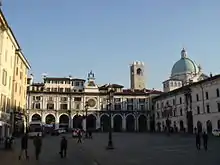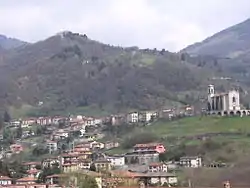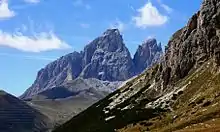| Race details | |||||||||||||||||||||||||||||||||
|---|---|---|---|---|---|---|---|---|---|---|---|---|---|---|---|---|---|---|---|---|---|---|---|---|---|---|---|---|---|---|---|---|---|
| Dates | 12 May - 5 June 1983 | ||||||||||||||||||||||||||||||||
| Stages | 22 + Prologue, including one split stage | ||||||||||||||||||||||||||||||||
| Distance | 3,922 km (2,437 mi) | ||||||||||||||||||||||||||||||||
| Winning time | 100h 45' 30" | ||||||||||||||||||||||||||||||||
| Results | |||||||||||||||||||||||||||||||||
| |||||||||||||||||||||||||||||||||
The 1983 Giro d'Italia was the 66th running of the Giro. It started in Brescia, on 12 May, with an 8 km (5.0 mi) prologue and concluded in Udine, on 5 June, with a 40 km (24.9 mi) individual time trial. A total of 162 riders from eighteen teams entered the 22-stage race, that was won by Italian Giuseppe Saronni of the Del Tongo-Colnago team. The second and third places were taken by Italian Roberto Visentini and Spaniard Alberto Fernández, respectively.[1][2][3][4]
Amongst the other classifications that the race awarded, Saronni won the points classification, Lucien Van Impe of Metauro Mobili won the mountains classification, and Vivi-Benotto's Franco Chioccioli completed the Giro as the best neo-professional in the general classification, finishing sixteenth overall. Renault-Elf finishing as the winners of the team classification, ranking each of the twenty teams contesting the race by lowest cumulative time. The team points classification was won by Zor-Gemeaz Cusin.
Teams

A total of eighteen teams were invited to participate in the 1983 Giro d'Italia.[5] Each team sent a squad of nine riders, which meant that the race started with a peloton of 162 cyclists.[6][7] The presentation of the teams – where each team's roster and manager are introduced in front the media and local dignitaries – took place at the Piazza della Loggia in Brescia on 10 May and was televised in Italy on Network 1.[7] From the riders that began this edition, 140 made it to the finish in Udine.[1][6]
The teams entering the race were:[5]
|
|
|
Route and stages

The route for the 1983 edition of the Giro d'Italia was revealed to the public by head organizer Vincenzo Torriani on 19 February 1983.[8][9][10] Covering a total of 3,922 km (2,437 mi), it included four time trials (three individual and one for teams), and fifteen stages with categorized climbs that awarded mountains classification points.[6][10] Seven of these fifteen stages had summit finishes: stage 4, to Todi; stage 6, to Campitello Matese; stage 9, to Montefiascone; stage 10, to Bibbiena; stage 15, to Orta San Giulio; stage 17, to Colli di San Fermo; and stage 19, to Selva di Val Gardena.[9] The organizers chose to include two rest days. When compared to the previous year's race, the race was 88.5 km (55 mi) shorter and contained one more time trial. In addition, this race contained one more set of split stages.
| Stage | Date | Course | Distance | Type | Winner | ||
|---|---|---|---|---|---|---|---|
| P | 12 May | Brescia | Individual time trial | Stage Cancelled | |||
| 1 | 13 May | Brescia to Mantua | 70 km (43 mi) | Team time trial | Bianchi-Piaggio | ||
| 2 | 14 May | Mantua to Comacchio | 192 km (119 mi) | Plain stage | |||
| 3 | 15 May | Comacchio to Fano | 148 km (92 mi) | Plain stage | |||
| 4 | 16 May | Pesaro to Todi | 187 km (116 mi) | Stage with mountain(s) | |||
| 5 | 17 May | Terni to Vasto | 269 km (167 mi) | Stage with mountain(s) | |||
| 6 | 18 May | Vasto to Campitello Matese | 145 km (90 mi) | Stage with mountain(s) | |||
| 7 | 19 May | Campitello Matese to Salerno | 216 km (134 mi) | Stage with mountain(s) | |||
| 8 | 20 May | Salerno to Terracina | 212 km (132 mi) | Plain stage | |||
| 9 | 21 May | Terracina to Montefiascone | 225 km (140 mi) | Stage with mountain(s) | |||
| 10 | 22 May | Montefiascone to Bibbiena | 232 km (144 mi) | Stage with mountain(s) | |||
| 11 | 23 May | Bibbiena to Pietrasanta | 202 km (126 mi) | Stage with mountain(s) | |||
| 24 May | Rest day | ||||||
| 12 | 25 May | Pietrasanta to Reggio Emilia | 180 km (112 mi) | Stage with mountain(s) | |||
| 13 | 26 May | Reggio Emilia to Parma | 38 km (24 mi) | Individual time trial | |||
| 14 | 27 May | Parma to Savona | 243 km (151 mi) | Stage with mountain(s) | |||
| 15 | 28 May | Savona to Orta San Giulio | 219 km (136 mi) | Stage with mountain(s) | |||
| 16a | 29 May | Orta San Giulio to Milan | 110 km (68 mi) | Plain stage | |||
| 16b | Milan to Bergamo | 100 km (62 mi) | Stage with mountain(s) | ||||
| 17 | 30 May | Bergamo to Colli di San Fermo | 91 km (57 mi) | Stage with mountain(s) | |||
| 18 | 31 May | Sarnico to Vicenza | 178 km (111 mi) | Stage with mountain(s) | |||
| 1 June | Rest day | ||||||
| 19 | 2 June | Vicenza to Selva di Val Gardena | 224 km (139 mi) | Stage with mountain(s) | |||
| 20 | 3 June | Selva di Val Gardena to Arabba | 169 km (105 mi) | Stage with mountain(s) | |||
| 21 | 4 June | Arabba to Gorizia | 232 km (144 mi) | Plain stage | |||
| 22 | 5 June | Gorizia to Udine | 40 km (25 mi) | Individual time trial | |||
| Total | 3,922 km (2,437 mi) | ||||||
Classification leadership

Four different jerseys were worn during the 1983 Giro d'Italia. The leader of the general classification – calculated by adding the stage finish times of each rider, and allowing time bonuses for the first three finishers on mass-start stages – wore a pink jersey. This classification is the most important of the race, and its winner is considered as the winner of the Giro.[11]
For the points classification, which awarded a purple (or cyclamen) jersey to its leader, cyclists were given points for finishing a stage in the top 15; additional points could also be won in intermediate sprints. The green jersey was awarded to the mountains classification leader. In this ranking, points were won by reaching the summit of a climb ahead of other cyclists. Each climb was ranked as either first, second or third category, with more points available for higher category climbs. The Cima Coppi, the race's highest point of elevation, awarded more points than the other first category climbs.[11] The Cima Coppi for this Giro was the Pordoi Pass. The first rider to cross the Pordoi Pass was Spanish rider Marino Lejarreta. The white jersey was worn by the leader of young rider classification, a ranking decided the same way as the general classification, but considering only neo-professional cyclists (in their first three years of professional racing).[11] Although no jersey was awarded, there was also one classification for the teams, in which the stage finish times of the best three cyclists per team were added; the leading team was the one with the lowest total time.[11]
The rows in the following table correspond to the jerseys awarded after that stage was run.
Final standings
| Legend | |||
|---|---|---|---|
| |
Denotes the winner of the General classification[6] | |
Denotes the winner of the Mountains classification[6] |
| |
Denotes the winner of the Points classification[6] | |
Denotes the winner of the Young rider classification[6] |
General classification
| Rank | Name | Team | Time |
|---|---|---|---|
| 1 | Del Tongo-Colnago | 100h 45' 30" | |
| 2 | Inoxpran-Lumenflon | + 1' 07" | |
| 3 | Zor-Gemeaz Cusin | + 3' 40" | |
| 4 | Malvor-Bottecchia | + 5' 55" | |
| 5 | Del Tongo-Colnago | + 7' 44" | |
| 6 | Alfa Lum-Olmo | + 7' 47" | |
| 7 | Zor-Gemeaz Cusin | + 8' 24" | |
| 8 | Zor-Gemeaz Cusin | + 9' 41" | |
| 9 | Metauro Mobili | + 10' 54" | |
| 10 | Atala-Campagnolo | + 12' 00" |
Points classification
| Rider | Team | Points | |
|---|---|---|---|
| 1 | Del Tongo-Colnago | 223 | |
| 2 | Sammontana | 149 | |
| 3 | Europ Decor-Dries | 139 | |
| 4 | Atala-Campagnolo | 120 | |
| 5 | Eorotex-Magniflex | 111 |
Mountains classification
| Rider | Team | Points | |
|---|---|---|---|
| 1 | Metauro Mobili | 70 | |
| 2 | Zor-Gemeaz Cusin | 43 | |
| 3 | Alfa Lum-Olmo | 27 | |
| Zor-Gemeaz Cusin | |||
| 5 | Bianchi-Piaggio | 23 |
Young rider classification
| Rider | Team | Time | |
|---|---|---|---|
| 1 | Vivi-Benotto | 101h 00" 52" | |
| 2 | Gis Gelati-Campagnolo | + 12' 16" | |
| 3 | Eorotex-Magniflex | + 20' 32" | |
| 4 | Termolan-Galli | + 30' 27" | |
| 5 | Gis Gelati-Campagnolo | + 35' 13" |
Team classification
| Team | Time | |
|---|---|---|
| 1 | Zor-Gemeaz Cusin | 300h 05' 39" |
| 2 | Inoxpran-Lumenflon | + 10' 45" |
| 3 | Del Tongo-Colnago | + 17' 30" |
References
Citations
- 1 2 "Saronni, La Vida En Rosa" [Saronni, the Life in Rose] (PDF) (in Spanish). El Mundo Deportivo. 6 June 1983. p. 32. Archived from the original on 8 May 2014. Retrieved 27 May 2012.
- ↑ "Visentini no pogué impedir el triomf final de Saronni" [Visentini could not prevent the final triumph Saronno]. El Punt (in Catalan). Hermes Comunicacions S.A. 7 June 1983. p. 30. Archived from the original (PDF) on 12 July 2014. Retrieved 27 May 2012.
- ↑ Jean Montois (7 June 1983). "Les bonificacions van fer guanyador Saronni" [Bonuses were winning Saronni]. Avui (in Catalan). Hermes Comunicacions S.A. Archived from the original on 12 July 2014. Retrieved 27 May 2012.
- ↑ "Special Editions – 1983". Giro d'Italia. La Gazzetta dello Sport. 2018. Archived from the original on 2 October 2018. Retrieved 27 May 2019.
- 1 2 "Los Parincipales Participantes" [The Principal Participants] (PDF) (in Spanish). El Mundo Deportivo. 12 May 1983. p. 24. Archived (PDF) from the original on 1 February 2015. Retrieved 27 May 2012.
- 1 2 3 4 5 6 7 8 9 10 11 12 13 Bill and Carol McGann. "1983 Giro d'Italia". Bike Race Info. Dog Ear Publishing. Archived from the original on 13 April 2014. Retrieved 2012-08-06.
- 1 2 Gian Paolo Ormezzano (11 May 1983). "Oggi la passerella a Brescia" [Today the catwalk in Brescia] (PDF). La Stampa (in Italian). Editrice La Stampa. p. 21. Retrieved 27 May 2012.
- ↑ "Un Giro <<morbido>> fatto per Saronni" [A Tour <<soft>> done for Saronni] (PDF). La Stampa (in Italian). Editrice La Stampa. 20 February 1983. p. 21. Retrieved 27 May 2012.
- 1 2 Gino Sala (20 February 1983). "Sara la corsa dei cinque dolomitici Avversari di gran riguardo per <<Beppe>> saranno Contini, Baronchelli, Battaglin, De Wolf, Van Impe, e Moser" [Sara race of the five Dolomite Opponents of much regard for <<Beppe>> will Contini, Baronchelli, Battaglin, De Wolf, Van Impe, and Moser] (PDF). l'Unità (in Italian). PCI. p. 21. Archived from the original (PDF) on 2015-02-07. Retrieved 27 May 2012.
- 1 2 3 "Etapa <<reina>> a dos dias del final" [Queen Stage two days from the end] (PDF). El Mundo Deportivo (in Spanish). El Mundo Deportivo S.A. 20 February 1983. p. 36. Archived (PDF) from the original on 7 February 2015. Retrieved 27 May 2012.
- 1 2 3 4 Laura Weislo (13 May 2008). "Giro d'Italia classifications demystified". Cycling News. Future Publishing Limited. Archived from the original on 8 May 2013. Retrieved 13 July 2013.
- ↑ "Clasificaciones" (PDF). El Mundo Deportivo. 5 June 1983. p. 43.